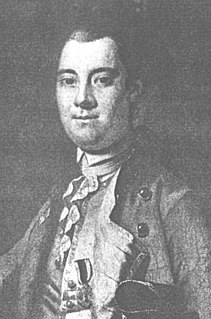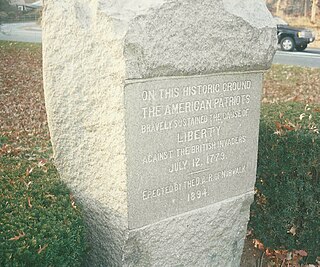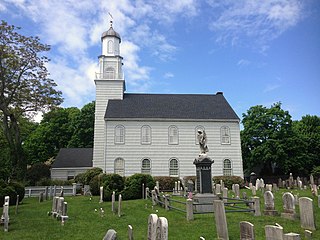
Timeline of the American Revolution — timeline of the political upheaval culminating in the 18th century in which Thirteen Colonies in North America joined together for independence from the British Empire, and after victory in the Revolutionary War combined to form the United States of America. The American Revolution includes political, social, and military aspects. The revolutionary era is generally considered to have begun with the passage of the Stamp Act in 1765 and ended with the ratification of the United States Bill of Rights in 1791. The military phase of the revolution, the American Revolutionary War, lasted from 1775 to 1783.

The 1779 Sullivan Expedition was a United States military campaign during the American Revolutionary War, lasting from June to October 1779, against Loyalists and the four British allied Nations of the Iroquois. The campaign was ordered by George Washington, in response to the 1778 Iroquois–British attacks on Wyoming, German Flatts and Cherry Valley, with the aim of "taking the war home to the enemy to break their morale". The Continental Army carried out a scorched-earth campaign, chiefly in the lands of the Iroquois Confederacy in what is now Pennsylvania and western New York state.

Lieutenant General William Tryon was a British Army general and colonial official who served as the 39th governor of New York from 1771 to 1777, assuming the office after having served as the eighth governor of North Carolina from 1764 to 1771.

The Battle of Stony Point took place on July 16, 1779, during the American Revolutionary War. In a well-planned and -executed nighttime attack, a highly trained select group of George Washington's Continental Army troops under the command of Brigadier General "Mad Anthony" Wayne defeated British troops in a quick and daring assault on their outpost in Stony Point, New York, approximately 30 mi (48 km) north of New York City.

The Mount Hope Bay raids were a series of military raids conducted by British troops during the American Revolutionary War against communities on the shores of Mount Hope Bay on May 25 and 31, 1778. The towns of Bristol and Warren, Rhode Island were significantly damaged, and Freetown, Massachusetts was also attacked, although its militia resisted British attacks more successfully. The British destroyed military defenses in the area, including supplies that had been cached by the Continental Army in anticipation of an assault on British-occupied Newport, Rhode Island. Homes as well as municipal and religious buildings were also destroyed in the raids.
Samuel Holden Parsons was an American lawyer, jurist, general in the Continental Army during the American Revolutionary War, and a pioneer to the Ohio Country. Parsons was described as "Soldier, scholar, judge, one of the strongest arms on which Washington leaned, who first suggested the Continental Congress, from the story of whose life could almost be written the history of the Northern War" by Senator George F. Hoar of Massachusetts
The 6th Connecticut Regiment was raised on May 1, 1775, at New Haven, Connecticut, as a provincial regiment for the Continental Army. It then became a regiment of the Continental Line on January 1, 1776, designated the 10th Continental Regiment, and a regiment of the Connecticut Line on January 1, 1777, again designated the 6th Connecticut. The regiment saw action at the siege of Boston, the Battle of Long Island, the New York Campaign, and its colonel and company of light infantry served in the Corps of Light Infantry at the Battle of Stony Point. The regiment was merged into the 1st Connecticut Regiment on January 1, 1783, at West Point, New York and disbanded on November 16, 1783.

The Yorktown or Virginia campaign was a series of military maneuvers and battles during the American Revolutionary War that culminated in the siege of Yorktown in October 1781. The result of the campaign was the surrender of the British Army force of General Charles Earl Cornwallis, an event that led directly to the beginning of serious peace negotiations and the eventual end of the war. The campaign was marked by disagreements, indecision, and miscommunication on the part of British leaders, and by a remarkable set of cooperative decisions, at times in violation of orders, by the French and Americans.

The history of Norwalk, Connecticut ranges from pre-contact cultures and Native Americans to the 21st century.

East Norwalk is a neighborhood of Norwalk, Connecticut, located mostly in Norwalk's third taxing district with segments of its northernmost area within the first and fifth taxing districts. As one of the earliest settlements of Norwalk, it was so marked with a block of 'suitably inscribed' 'native granite' formally located on the corner of Fitch Street and East Avenue.

The Meigs Raid was a military raid by American Continental Army forces, under the command of Connecticut Colonel Return Jonathan Meigs, on a British Loyalist foraging party at Sag Harbor, New York on May 24, 1777 during the American Revolutionary War. Six Loyalists were killed and 90 captured while the Americans suffered no casualties. The raid was made in response to a successful British raid on Danbury, Connecticut in late April that was opposed by American forces in the Battle of Ridgefield.

The Northern theater of the American Revolutionary War after Saratoga consisted of a series of battles between American revolutionaries and British forces, from 1778 to 1782 during the American Revolutionary War. It is characterized by two primary areas of activity. The first set of activities was based around the British base of operations in New York City, where each side made probes and counterprobes against the other's positions that sometimes resulted in notable actions. The second was essentially a frontier war in Upstate New York and rural northern Pennsylvania that was largely fought by state militia companies and some Indian allies on the American side, and Loyalist companies supported by Indians, British Indian agents, and occasionally British regulars. The notable exception to significant Continental Army participation on the frontier was the 1779 Sullivan Expedition, in which General John Sullivan led an army expedition that drove the Iroquois out of New York. The warfare amongst the splinters of the Iroquois Six Nations were particularly brutal, turning much of the Indian population into refugees.
The 54th Regiment of Foot was an infantry regiment of the British Army, raised in 1755. Under the Childers Reforms it amalgamated with the 39th (Dorsetshire) Regiment of Foot to form the Dorsetshire Regiment in 1881.

The Battle of Ridgefield was a battle and a series of skirmishes between American and British forces during the American Revolutionary War. The main battle was fought in the village of Ridgefield, Connecticut, on April 27, 1777. More skirmishing occurred the next day between Ridgefield and the coastline near Westport, Connecticut.

Calf Pasture Beach is a historically significant park and beach in Norwalk, Connecticut.

Major General Charles Grey raided the Massachusetts communities of New Bedford, Fairhaven, and Martha's Vineyard in September 1778 as part of British operations in the American Revolutionary War. The raid was one of the first in a series between 1778 and 1781 executed by the British against American coastal communities.

Charles, Earl Cornwallis (1738–1805) was a military officer who served in the British Army during the American War of Independence. He is best known for surrendering his army after the 1781 siege of Yorktown, an act that ended major hostilities in North America and led directly to peace negotiations and the eventual end of the war.

The Battle of Norwalk was a series of skirmishes between the Thirteen Colonies and Great Britain during the American Revolutionary War. The attack was one part of a series of raids on coastal Connecticut towns collectively known as Tryon's raid. The battle was fought in Norwalk, Connecticut on July 11, 1779. 70th (Surrey) Regiment of Foot of Great Britain commanded by Major General William Tryon arrived on July 10, 1779. They marched in a two pronged attack on both sides of the Norwalk River. They followed a path along what is today East and West Avenues burning everything along the way. Only six houses within the business district at Head of River were spared.

The Battle of Setauket was a failed attack during the American Revolutionary War on a fortified Loyalist outpost in Setauket, Long Island, New York, by a force of Continental Army troops from Connecticut under the command of Brigadier General Samuel Holden Parsons.

The Burning of Fairfield refers to the action of the American Revolutionary War at Fairfield, Connecticut on July 7, 1779, when a British landing force under the command of General William Tryon attacked the town, engaged and defeated its militia forces, and burned down the vast majority of buildings in Fairfield.

















